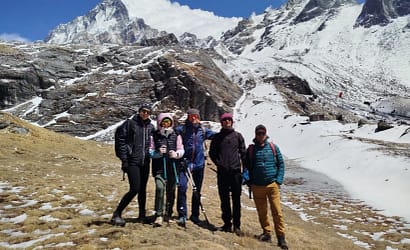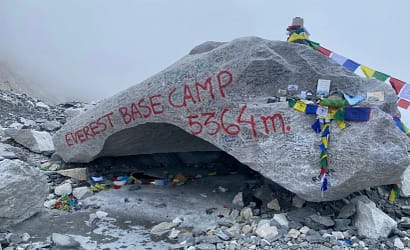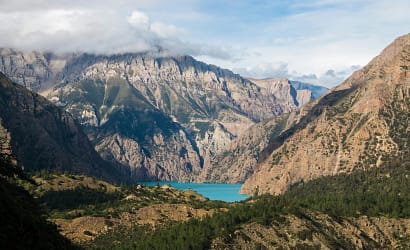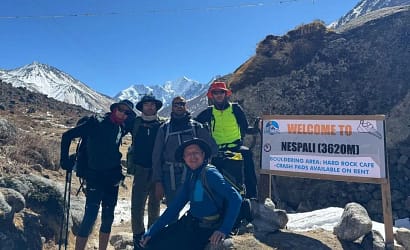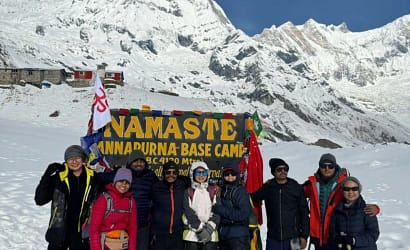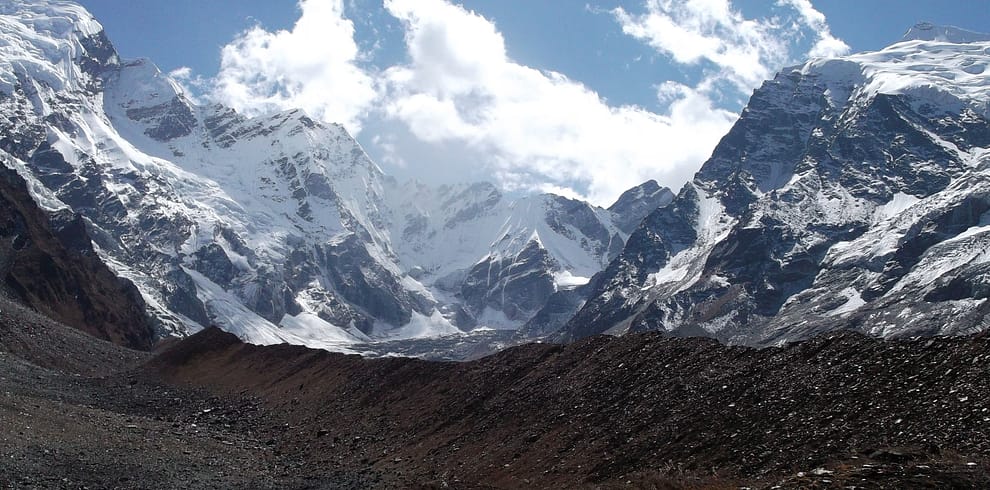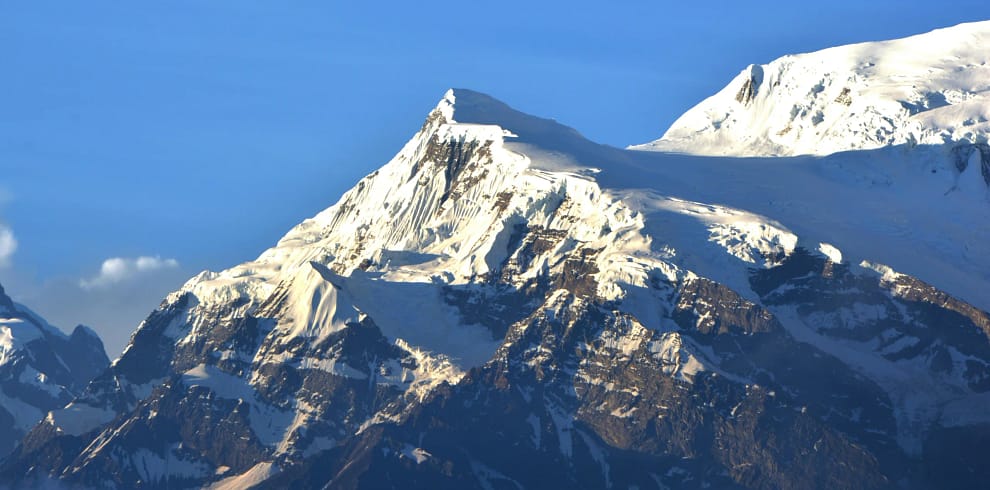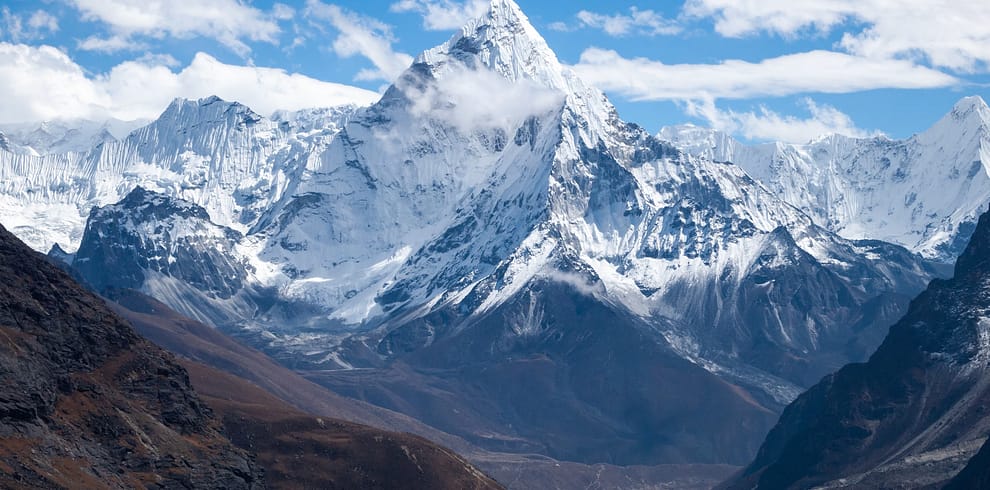The Pumori expedition stands at 7,161m and is 8km west of Everest. Also known as the “Daughter of Everest,” Pumori is a highly rewarding and technically difficult climb in the Khumbu. Its pyramidal shape and proximity to Everest Base Camp makes it the mountaineers’ preferred option to avoid the crowds but get an equally exhilarating Himalayan experience. The trek starts with a thrilling flight to Lukla and then ascending through traditional Sherpa villages like Namche Bazaar and Dingboche to get culture and acclimatization.
Pumori climbing involves snowface slopes, ice walls and ridges which requires good technical skills and physical strength. After establishing the base camp at around 5,300m, high camps are set up for safe journey to the summit. Climbing is done by professional Sherpa guides and route fixing, logistic support and protection is also provided by them. It’s a challenging climb but the reward is well worth it – leaning on the Pumori summit provides stunning views of Everest, Lhotse, Nuptse and other Himalayan giants.
This 34 day expedition is for experienced climbers who want to take on a high altitude, semi-technical peak with fewer crowds than Everest. With Blaze Mountain’s professional support, carefully planned acclimatization and full logistical services you will be fully equipped for a summit bid. Pumori is not just a climb – it’s a journey through spectacular landscapes, remote highlands and the heart of Sherpa culture – it’s an unforgettable Himalayan adventure.
Trek Note: Pumori Expedition
Trek Duration: 34 Days
Max Elevation: 7,161m
Trek Grade: Very Strenuous & Technical
Best Season: Spring (April–May) & Autumn (September–October)
Accommodation: Teahouses & Camping
Permits Required: Sagarmatha National Park Permit, Khumbu Rural Municipality Permit, Climbing Permit.
The Pumori Expedition is an incredible climb in the Khumbu next to Everest. Starting our expedition in Kathmandu we will fly to Lukla and go trekking on the classic Everest Route through Sherpa villages such as Namche Bazaar, Tengboche and Dingboche will help us acclimatize and appreciate the culture, mountainous terrain and scenery in the Khumbu Valley.
Once at Pumori Base Camp at 5,300 meters we will begin the climbing with establishing three more higher camps. There will be some steep snow and ice sections, narrow ridges, and glaciated sections, so strong climbing ability and fitness will important. You will have experienced Sherpa guides to help fix the routes, carry gear and ensure safe passage on the way up.
From the summit of Pumori at 7,161 meters you will be rewarded with amazing views of Everest, Lhotse, Nuptse and the Khumbu Icefall. The descent will be the same path back to Lukla then return to Kathmandu. This climb would be for experienced climbers who want a lesser known but still aesthetic and challenging peak in the Everest region of Nepal.
Additional Information:
You can access full details regarding the Pumori Expedition from our website. If you need any extra information or extra service, feel free to contact us. To meet our agent, please follow the link, and/or if you want to talk to us directly, you can call our office at: +977-1-4522505.
Overviews
Alright, let’s talk Pumori. This isn’t just another hike; it’s the sort of trip that’ll chew you up, spit you out, and have you asking for seconds. We’re talking about a beast of a mountain camped out just eight kilometers west of Everest herself—close enough you could probably throw a snowball and annoy a Yeti or two on the big E. Pumori’s hanging out at a cool 7,161 meters, and people call her the “Daughter of Everest,” which, honestly, sounds a bit too wholesome for how gnarly this climb really is. Photogenic? Sure, if snow pyramids in the stratosphere are your thing. But don’t let the pretty face fool you—she’ll test you, especially if you think you’ve already “done” 6,000 or 7,000 meters somewhere. Ha. Strap in.
You kick off in Kathmandu, and it’s a whirlwind—permits, gear shakedowns, a general vibe of organized chaos. Then you take that infamous flight to Lukla, the kind where you pray a little no matter how tough you are. From Lukla, you hit the classic trek: Phakding, Namche, Tengboche, and Dingboche. Trust me this isn’t a boring trudge. You ease into the altitude (your lungs will thank you later), and you actually get to hang with the Sherpa crew easily the chillest, toughest folks you’ll meet. Old monasteries? Check. Views of Ama Dablam, Everest, and Lhotse? You can’t swing an ice ax without hitting an epic vista.
And then: Base Camp, 5,300 meters. The actual climbing bit starts now. Picture this: three camps stacked up the mountain—Camp I at 5,700m, Camp II at 6,200m, and Camp III at around 6,800 m—each one feeling like you’re pitching your tent somewhere halfway to Mars. The climb? Steep snow slopes, sketchy crevasses, icy hurdles, knife-edge ridges. None of this is for the casual weekend warrior. You have to bring serious fitness and some hardcore mountaineering mojo, or Pumori will hand you your ego on a snow platter. Luckily, the Sherpa guides are legit legends, fixing ropes and pulling off the kind of safety wizardry that’s half tradition, half superhero stuff.
Summit day hits different. The view? Straight-up eye-candy overload: Everest, Lhotse, Nuptse, Lingtren, and the whole Khumbu glacier unspooling below like it’s been set up just for you. And after you’ve poured your heart, lungs, and probably several unmentionable body fluids into standing on top… You head down, bouncing through places like Lobuche and Pangboche, eventually stumbling back to Lukla and catching the flight out (assuming the weather gods are feeling cooperative). Pumori isn’t just another notch on a climber’s belt, you know? It’s a full-tilt hit of Himalayan madness part pain, part glory, all adventure. Did you finish that? Good luck topping it.
Specialty of Pumori Expedition:
Alright, so here’s the real deal about the Pumori Expedition: if you’re a sucker for jaw-dropping scenery and aren’t afraid to break a sweat (like, a lot of sweat), this mountain will absolutely wreck you—in a good way. Nicknamed the “Daughter of Everest,” Pumori juts up to 7,161 meters and, man, it looks like somebody stuck a giant white pyramid right next to Kala Patthar. You get those wild Himalayan views without being crowded out by Everest groupies all pushing for selfies and Wi-Fi.
Now, climbing this beast isn’t just a casual stroll. Nope. Think killer snow slopes, razor-edged ridges, sketchy ice walls, and more crevasses than you can shake an ice axe at. Not for newbies or your uncle with a shiny new puffy jacket—this is serious type-two fun for folks with some solid climbing chops. You aren’t just gunning it to the top, either; there are three high camps you’ve gotta set up along the way, and each one’s basically a balancing act between staying alive and actually acclimatizing enough to have a fighting chance at the summit.
Honestly, Pumori’s kind of the “training montage” before you go after the 8,000-meter big fish like Everest or Lhotse. Think of it as Rocky hitting the snow slopes instead of punching meat in a fridge.
But the magic isn’t only up high you actually kick things off on the legendary Everest trail. We’re talking vibrant Sherpa villages (Namche and Tengboche ring a bell?), prayer flags everywhere, and little kids in rubber boots waving at you. Those ancient monasteries? Yeah, you’ll definitely end up burning a yak-butter candle or two, either for luck or just because the vibe is unreal.
And the views? Forget it. You get an all-star lineup: Everest, Lhotse, Nuptse, Ama Dablam—all photobombing your summit snaps. So bottom line: Pumori is a spicy mix of hard-core climbing, wild Himalayan eye-candy, and some A+ culture along for the ride. It’s not for the faint of heart, but if you make it? Those bragging rights are gonna be phenomenal.
Is the Pumori Expedition Right for Trekkers and Climbers?
- The Pumori Expedition is best suited for experienced climbers who have prior knowledge of high-altitude and technical mountaineering.
- It is not ideal for beginners or casual trekkers, as the route involves steep ice walls, exposed ridgelines, and the use of fixed ropes.
- Climbers who have successfully summited peaks like Island Peak, Mera Peak, or any 6,000m+ mountains will find Pumori to be a natural next step.
- Trekkers can enjoy the approach to base camp via the Everest Base Camp trail, but only trained climbers should attempt the ascent beyond base camp.
- This expedition is also a good preparation climb for those planning to tackle 8,000-meter peaks like Everest or Lhotse in the future.
- If you are physically fit, mentally prepared, and ready for a technical challenge, the Pumori Expedition can be one of the most rewarding climbs in the Himalayas.
Who Should Join the Pumori Expedition?
- Experienced trekkers who have completed high-altitude treks and want to transition into mountaineering.
- Intermediate to advanced climbers looking for a 7,000-meter peak before attempting 8,000-meter summits.
- Adventure seekers who enjoy remote, off-the-beaten-path Himalayan expeditions.
- Physically fit individuals with a strong mindset and the ability to endure long, challenging climbs.
The Pumori Expedition is an incredible experience that will push your boundaries and reward you with breathtaking Himalayan vistas and a genuine sense of success if you possess the willpower, physical stamina, and enthusiasm for high-altitude adventure. Climbers who are prepared to take on the challenge can participate in this adventure since Blaze Mountain guarantees a safe and well-supported trek.
Best Season for Pumori Expedition:

Look, climbing Mount Pumori isn’t exactly a stroll in the park. You pick the wrong season, and you’re just begging for trouble or a one-way ticket to Frostbite Ville. Best time? Hands down, you wanna aim for spring (March to May) or autumn (September to November). That’s when Mother Nature chills out a bit—kind of gives you a fighting chance with decent weather, good visibility, not as many, you know, “surprise” storms. Sure, you could roll the dice and show up in summer or winter (June–August and December–February), but, honestly? Big mistake. Summer’s all about the monsoon tantrums think relentless rain, avalanches waiting to happen, clouds that won’t move. Winter? Just ice, wind, and the type of cold that makes you rethink every life decision. Not ideal unless you’re trying to practice for an Arctic expedition. So, yeah, if you’ve got any sense in you (and I hope you do if you’re reading this), stick with spring or fall. Here’s a quick look at what each season throws at you:
- Spring (March–May) – The Sweet Spot for Climbing
Honestly, if you ask most climbers, spring is the time to go for Pumori. Temps aren’t brutal, storms tend to chill out, and you don’t have to worry nearly as much about avalanches ruining your day. Plus, you get those long daylight hours—which, let’s be real, are a lifesaver when you’re hauling yourself up a mountain. The rhododendrons go crazy this time of year, too, so on your way to base camp, you’ll get a bonus hit of bright colors and that whole “Himalayan-through-a-kaleidoscope” vibe. All in all? Solid odds for hitting the summit safely. - Autumn (September–November) – The Photographer’s Dream
Now, autumn’s no slouch either. Right after the monsoon bounces, the skies clear up, serving you jaw-dropping vistas of Everest, Lhotse, Ama Dablam—honestly, it’s kind of unfair how gorgeous it gets. The temps edge into chilly territory, but nothing wild if you’ve packed smart. The snow’s pretty reliable, so technical climbing’s on point. If snapping some Instagram gold or just soaking up those painted-orange hills is your thing, autumn’s gonna hit the spot. Nights get cold up high, but with decent gear and a bit of hustle? Totally doable. - Summer/Monsoon (June–August) – Nope, Nope, Nope
So, summer’s basically “nope season.” Monsoon rolls in, dumping rain, coating the whole region in thick clouds, and turning trails into mud wrestling pits. Visibility’s trash, landslides like to crash the party, and the avalanches don’t exactly take a vacation. Sure, the Khumbu goes full jungle with all the green, which is neat, but forget technical climbs—Pumori’s a hard pass if you value not sliding off a cliff. - Winter (December–February) – For the Masochists
Winter? Oh man, only the hardcore need apply. Think insane cold, howling winds, and snow piling up like a bad joke. Pumori’s already tough, but toss in all that extra ice and snow? Only folks with serious winter game and next-level gear should even think about it. Days are short, risks are high, and honestly, unless you’re out for bragging rights with other mountaineering lunatics, give winter a miss.
So yeah, spring and autumn those are the real MVPs for a Pumori expedition. Steady weather, better safety, epic views…pretty much what everyone’s after. Summer and winter? Best left to thrill-seekers or people who collect near misses for fun. At Blaze Mountain, we’ve got your back with guides who actually know what they’re doing, careful planning, and safety that’s more than just a slogan no matter when you’re thinking of going.
Weather Table of Pumori According to Altitudes
| Altitude (m) | Day Temperature (°C) | Night Temperature (°C) | Weather Conditions |
|---|---|---|---|
| 2,800m – 3,500m | 15°C to 20°C | 5°C to 10°C | Mild days, chilly nights, mostly clear skies with occasional mountain breezes. |
| 3,500m – 5,000m | 10°C to 5°C | 0°C to -10°C | Colder temperatures, dry air, increasing wind chill; snow possible at higher altitudes. |
| 5,000m – 6,500m | 0°C to -5°C | -10°C to -20°C | Harsh and cold, stronger winds, snow and ice more prevalent, rapid weather shifts. |
| 6,500m – 7,161m (Summit) | -10°C to -20°C | -20°C to -35°C | Extreme cold, fierce winds, very low oxygen levels, blizzards and whiteout possible. |
Local Culture and Tradition Around Pumori:
So, here’s the thing if you’re stomping your way up toward Pumori, you’re not just surrounded by jaw-dropping mountains and the kind of air that makes you question life choices. You’re also swimming in Sherpa culture, which is, honestly, the real deal. Tibetan Buddhist vibes everywhere. You wander through spots like Namche Bazaar, Tengboche, Dingboche you know, those villages they always hype in trekking blogs. And everywhere, it’s like, boom: prayer flags flapping like crazy, mani walls stacked with spinning wheels, and these monasteries that look straight-up cut out of a dream. Now Tengboche Monastery? That place is basically the spiritual engine of the whole region. Most climbers swing by to get blessed by the monks bunch of chanting, wafting incense, and yes, a solid amount of crossing-your-fingers for good luck. The Sherpas, they take the mountains super seriously; lotta rituals, deep respect, that sort of thing.
And if you’re worried about being just another clueless tourist, relax a Sherpa grandma will probably shove a cup of salty butter tea in your hand before you know what hit you. Their hospitality? Next level. Life up there kinda revolves around what the season’s throwing at them, like herding yaks, scrabbling together potatoes, stacking firewood, or guiding lost souls in brand-new Gore-Tex.
Tourism’s kinda changed things, sure, but honestly, the old-school Sherpa language, gear, and wild festivals those are holding strong. You want a real treat? Roll through when Dumji or Mani Rimdu rolls around. Mask dances, wild ceremonies, monks getting down those festivals are something else. Basically, it’s a mashup of nature, faith, and tradition, all colliding into this crazy, unforgettable atmosphere. Climbing Pumori isn’t just about the summit half the adventure is just soaking in all that culture. Totally worth every freezing step, if you ask me.
Food & Accommodation Facilities During Pumori Expedition:
The Pumori Expedition ensures that climbers and trekkers are adequately nourished and well-rested throughout their journey by offering a range of hearty local meals and familiar Western dishes. Despite the remoteness and high-altitude challenges of the route, available facilities strive to provide comfort, warmth, and essential nourishment needed for a demanding expedition. Here’s what you can expect:
Food Options
During the Pumori Expedition, trekkers and climbers can enjoy a nutritious mix of traditional Himalayan food and basic Western meals to keep energy levels stable.
- Local Cuisine: Meals like Dal Bhat (rice and lentils), Tsampa (roasted barley flour), Thukpa (noodle soup), Sherpa stew, and Tibetan bread are commonly served along the route. These meals are rich in carbohydrates and ideal for high-altitude stamina and warmth.
- Western Food: Many teahouses and lodges along the trail offer simple Western meals such as pasta, fried eggs, pancakes, sandwiches, and potatoes. These options provide variety and comfort for those seeking familiar tastes during the climb.
- Refreshments & Beverages: Tea, coffee, hot chocolate, and energy drinks are readily available. Trekkers may also find light snacks like biscuits, energy bars, and nuts in lower-altitude villages or bring them along for higher elevations.
Accommodation Options
Accommodation throughout the Pumori Expedition ranges from cozy teahouses in lower elevations to organized tented camps near the base and higher camps.
- Teahouses & Lodges: In villages like Namche Bazaar, Lobuche, and Gorakshep, trekkers will stay in traditional teahouses. These are modest yet comfortable, typically offering private or shared rooms, warm meals, and basic amenities like shared bathrooms and dining areas.
- Camping at Higher Altitudes: Once climbers reach Pumori Base Camp and beyond, camping becomes the primary form of accommodation. Tents are set up with proper insulation and support, with dining tents and kitchen tents organized by the expedition team. Meals are prepared by experienced cooks and support staff.
- High Camps: As climbers ascend to higher camps (Camp I, II, III), accommodations are in technical alpine tents, designed to withstand harsh conditions. Though minimalistic, these provide essential protection and rest, with meals focused on high-energy, lightweight foods.
The Pumori Expedition makes sure climbers are well equipped for the demands of high-altitude mountaineering by providing a well-balanced combination of local hospitality, nutritious food, and useful housing. Comfort and success on the mountain are significantly improved by this well-considered configuration.
Necessary Gear for the Pumori Expedition:
Proper gear is essential to ensure safety, comfort, and success on the Pumori Expedition. The gear must be suitable for both the lower altitudes and the challenging high-altitude conditions of this trek.
Clothing:
- Base layers (thermal tops and bottoms): Essential for regulating body temperature by wicking away moisture and providing warmth.
- Fleece jacket or down jacket: These layers will keep you insulated and protected from cold weather, especially in high-altitude conditions.
- Waterproof and windproof outer layer: A durable jacket will protect against snow, rain, and strong winds, which are common at higher altitudes.
- Trekking pants (water-resistant): Water-resistant pants will ensure your legs stay dry and comfortable while trekking through varied terrain.
- Insulated gloves and warm hat: Cold hands and head can lead to discomfort and fatigue, so high-quality gloves and a hat are essential for warmth.
- Thermal socks and mountaineering boots (insulated): Thick, moisture-wicking socks combined with sturdy, insulated boots will protect your feet from the cold and ensure comfort on long days.
Climbing Equipment:
- Crampons: These will provide the necessary traction on icy surfaces, preventing slippage when navigating steep or frozen terrain.
- Ice axe: Vital for stability and support on ice and snow-covered slopes, offering extra grip when climbing.
- Harness and ropes: For safety during the climb, ensuring secure movement on vertical sections or ice-covered terrain.
- Climbing helmet: A must-have to protect your head from falling rocks and ice, especially on the summit push and other technical sections of the climb.
Camping and Sleeping:
- Sleeping bag (rated for extreme cold): A high-quality sleeping bag is necessary for warmth during cold nights at higher altitudes, ensuring you get proper rest.
- Sleeping pad for insulation: The sleeping pad provides both comfort and insulation from the cold ground, which is essential for a restful sleep.
- Tent for high-altitude camps: A weather-resistant, insulated tent is necessary to withstand high-altitude conditions, offering shelter from strong winds and snow.
- Headlamp with extra batteries: Essential for navigating the camp area and for any night-time treks. Ensure the headlamp is bright and reliable.
Health & Safety:
- First aid kit: A comprehensive first aid kit, including essentials like bandages, antiseptic, and pain relievers, is crucial for addressing injuries or emergencies on the trail.
- Altitude sickness medication: To prevent and manage symptoms of altitude sickness, carry recommended medications and always monitor your condition.
- Water purification system: Clean drinking water is not always available, so a purification system (tablets, filters, or purifiers) is essential for safe hydration.
- Sunscreen and lip balm: High-altitude sun exposure is intense, and protecting your skin from harmful UV rays is critical, so carry sunscreen and lip balm with SPF.
- Personal hygiene items: Items like biodegradable soap, wet wipes, and hand sanitizer will help maintain hygiene on the trail, where water sources may be limited.
Miscellaneous:
- Trekking poles: Essential for maintaining balance and reducing strain on the knees while trekking across uneven, rocky terrain.
- Sunglasses or goggles: Protect your eyes from harmful UV rays and snow glare at higher altitudes with high-quality sunglasses or goggles.
- Camera and power bank: Capture the incredible scenery and ensure your camera stays charged to document the journey.
- Backpack with rain cover: A reliable backpack will hold all your gear, and a rain cover will protect your equipment during sudden downpours or snowstorms.
Why Choose Pumori Expedition with Blaze Mountain?
Alright, here’s the real scoop on Blaze Mountain’s Pumori Expedition, no stiff brochure-speak. These folks? Total mountain nerds. They know the Pumori terrain like it’s their own backyard, and the guides are basically high-altitude wizards certified, seasoned, and actually care if you make it back in one piece. No kidding, your safety and sanity are a big deal to them.From touchdown in Nepal to that sweet, exhausted stumble back down the mountain, they’ve got you. Acclimatization schedules that don’t suck, tents that won’t collapse on your face, grub that goes beyond instant noodles yeah, Blaze Mountain doesn’t mess around.
Everything’s set up so you can obsess over the view, not logistics. Personal touch? Heck yes. They’ll wrangle permits, sort your ride, pitch high camp in safe spots basically, you just climb and try not to embarrass yourself on ladders. Plus, they don’t treat the Himalayas like a theme park there’s real respect for the local culture, and they go out of their way to not trash the place. Bottom line: this isn’t some cookie-cutter ‘adventure package.’ With Blaze Mountain, Pumori isn’t just a checkmark on your bucket list. It’s the kind of story you’ll be re-telling at every dinner party for the next decade.
Trip Highlights Pumori Expedition
- Reach the summit of Mt. Pumori at 7,161 meters, a prominent and technical peak near Everest.
- Witness stunning panoramic views of Everest, Lhotse, Nuptse, Ama Dablam, and the Khumbu Glacier.
- Ideal for experienced climbers aiming to prepare for 8,000-meter peaks like Everest or Manaslu.
- Trek through the legendary Khumbu region, passing iconic villages such as Namche Bazaar, Tengboche, and Gorakshep.
- Acclimatize and climb through multiple high-altitude camps with challenging ice, rock, and mixed terrain.
- Experience authentic Sherpa culture and visit sacred monasteries deeply rooted in Himalayan Buddhist traditions.
- Benefit from full expedition support including expert guides, porters, meals, equipment, and strict safety measures.


